|
| |
|
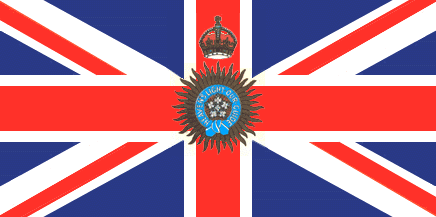
The flag of Indian Empire from 1879 to
1946. This flag fluttered atop Fort William in Calcutta and many other public
buildings but was seen as a symbol of oppression by nationalists who were to
eventually lead India to freedom from European rule. |
On November 1, 1858, Queen Victoria's proclamation was read
at the Grand Durbar held in Allahabad. The Queen assumed the Government of India
with Calcutta as the Royal Capital. The capital indeed was befitting royalty at
that time. As a contemporary noted, Calcutta's buildings were "all white,
their roofs invariably flat, surrounded by light colonnades, and their fronts
relieved by lofty columns supporting deep verandahs. Calcutta's growth was on,
too. In spite of the turmoil due to the War of Independence, the University of
Calcutta was established in 1857. The new municipal corporation completed the
public sewerage system in 1859, and the filtered water distribution network in
1860. The prosperity of Calcutta invited more immigrants, mainly Armenians from
Iran, Jews from Afghanistan and Iraq, Chinese and Europeans, besides people from
all parts of India. Everybody came because of the excellent law and order
situation or to escape persecution. Calcutta, the last word in colonialism, was
curiously enough, becoming a citadel of freedom simultaneously.
|
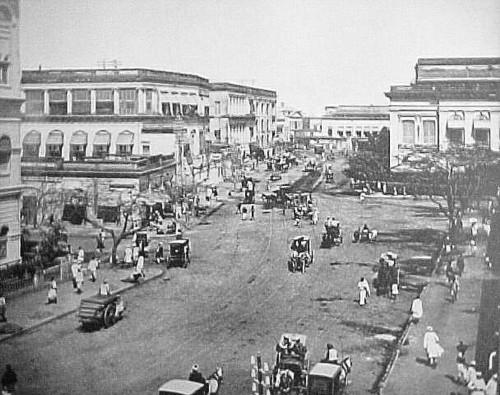
Clive Street, 1890 (photograph, courtesy
Bourne & Shepherd). To the north of the old Fort William, Clive Street
became the mercantile hub of the greatest city in Asia at the time.
Headquarters for the stock exchange, banks, shipping lines and merchant and
engineering firms Clive Street was the citadel of laissez faire in the East.
Today, renamed Netaji Subhas Road, Clive Street is the address for the most
business conglomerates in Calcutta. |
Calcutta's reputation as a trading center began to wane at
about this time. The indigo and saltpeter markets collapsed worldwide. China's
anti-opium movement was gaining ground thus choking Calcutta's opium exports. In
1869, the opening of the Suez Canal made Bombay the closest port to Europe and
robbing Calcutta of some of its share of the Indo-European trade. The business
houses on Clive Street were however, not slow to react. Overnight, companies
like Martin Burn, Andrew Yule, Williamson Magor and others moved into a new area
of business. Tea had been cultivated in Assam and Darjeeling for a few years
now, and had been found to be superior to the varieties from China. Overnight,
caskets of tea began to be auctioned on Brabourne Road and began making their
way to the teapots of tea lovers around the world. Not much has changed since
then. The auctions on Brabourne Road continue to this day at the Tea Board
Office, and is indeed a sight every morning. The same companies also diversified
into the other development industries, like metal casting and construction, a
reputation that has survived to this day. This was the time when Calcutta
changed from a trading port to a manufacturing base.
|

The Imperial General Post Office, 1890
(picture postcard). Built on the site of the old Fort William, the General
Post Office, as it is known today is an imposing edifice on the face of
Calcutta. |
|
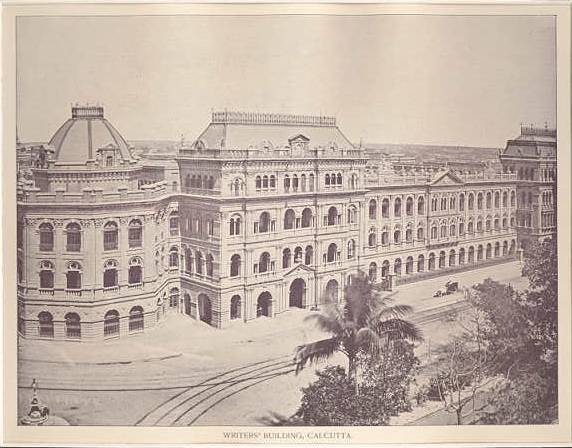
Writers' Building, 1890 (picture
postcard). Then the Secretariat of the Imperial Government of India and today
the secretariat of the Government of West Bengal. Notice the tram lines in
front of the building. |
The 1870s was an important decade for Calcutta. The growth
of public services was remarkable. Horse-drawn tramcars arrived on the streets
of Calcutta in 1873, and a spanking new shopping mall, Stuart Hogg Market, threw
open its doors in 1874. Stuart Hogg Market was well stocked with stuff rarely
found in Asian markets. The first two hotels in Asia had come up in Calcutta
several decades ago. They were the Spence's Hotel, opened in 1830 and now
closed, and the Great Eastern Hotel, opened in 1841, now derelict and awaiting
restoration. Both hotels now grew up into one of the finest in the world. The
political awakening of the region also began at the same time. In 1876, Sir
Surendranath Banerjea founded the Indian Association, the first political
movement in Asia. The Indian Association House stands to this day at the
junction of Bowbazar Street and Central Avenue. In 1877, another Grand Durbar
was held, this time in Delhi, the old capital of the erstwhile Mogul Empire.
Queen Victoria assumed the title of Empress of India and Calcutta became the
Imperial Capital.
|

A label attributable to Jardine Skinner
& Co. of Calcutta from 1890, one of the trading houses that prospered
from the three way trade between London, Calcutta and Shanghai. Jardine
Skinner today has disappeared from all three cities but continues to business
in Hong Kong. |
Calcutta's growth as a major railway junction continued.
The East India Railway ran from Howrah all the way to the outskirts of Delhi in
the North. The Bengal Nagpur Railway ran from Howrah to Nagpur in Central India,
from where the Great Indian Peninsula Railway continued to Bombay. The East
Bengal Railway's line ran from Sealdah, then in the outskirts of Calcutta to the
tea gardens of Assam and Northern Bengal. The Grand Trunk Road was built to
replace the road built by Sultan Sher Shah Suri of Delhi in the sixteenth
century, and now ran from Howrah to Peshawar in the Hindukush mountains. As it
had been true for Rome in an earlier age, all roads now led to Calcutta. In
1886, a pontoon bridge was built to link Calcutta and Howrah without disrupting
the river traffic. Gaslights had been in Calcutta for a while only to be
replaced with electric lighting in 1899. In the 1890s, the largest
telecommunications project ever undertaken in the world bridged the two most
important cities of the world's greatest power. Siemens laid the first cable
between Calcutta and London. Calcutta had arrived as the second City of the
British Empire. In 1919, the construction of the Victoria Memorial was completed
and soon became the jewel in Calcutta's crown.
|
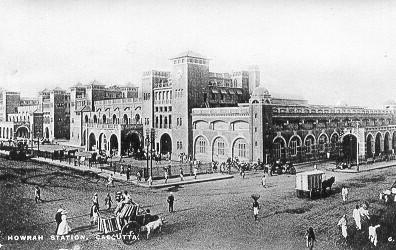
Howrah Station, 1905. Arguably one of the
world's busiest railway stations, it handled then as now, all the traffic
that went west from Calcutta. Situated across the river from the City of
Calcutta, its link to the city has been via a bridge. |
|
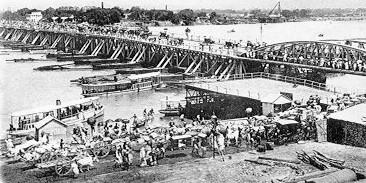
The old Howrah Bridge, from a photograph
of 1905. This bridge was built in 1886 to replace the ferry service to the
main railway station of Calcutta. This bridge had a retractable portion so as
not to encumber maritime traffic. In 1942, this bridge was replaced by the
cantilever Howrah Bridge that we know of today. The old bridge however
continues to be in operation in the Kidderpore Docks. |
Even while Calcutta grew as a city, not all was going well
with its administration. While the citizens of Calcutta had not participated in
the feudal uprising of 1857, their easier access to the world had fueled ideas
of liberty and nationalism. The British ruling class was fully aware of such
aspirations, and Lord Curzon, then Viceroy, promoted the idea of a participation
of the Bengal Presidency, creating two provinces, each of which would have the
local Bengalis as a minority. Such a partition received Royal Assent from King
Edward the Seventh on October 16, 1905. Instead of eliminating political
dissent, the partition inflamed nationalistic feelings and triggered a wave of
terrorism with British officials as targets. The terror culminated in an attack
on Writers' Building itself.
|
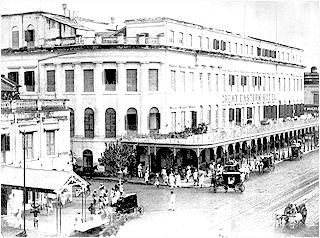
Great Eastern Hotel, from a 1915
photograph. Once regarded as the finest hostelry "east of the
Suez", Great Eastern once boasted of the only clone of the famous
Parisian restaurant Maxim's. The hotel has since gone into an abysmal decline
but there is talk of handing it over to a French company and restoring it to
its past glory. |
In 1911, King George the Fifth at his Coronation Durbar in
Delhi announced that the partition of Bengal had been rescinded. However, the
same announcement also included the transfer of the Imperial Capital to a city
to be built near Delhi. The reason cited was that Delhi was the traditional seat
of all emperors that had ruled India, and should be the same for the House of
Windsor, too, but the actual reason was that the British no longer considered it
safe to maintain political power in Calcutta. The Independence Movement
nevertheless, gained ground in Bengal and soon spread all over India. Calcutta's
leaders, however, belonged to two classes. One that advocated home rule on the
lines of Australia and Canada and the other that believed in terrorism to drive
the British from India. Both groups refused to be drawn along communal lines. By
the 1930s, other leaders from northern and central India, who stressed on
communal values and non-cooperation, had marginalized both groups.
|

The Indian headquarters of the Chartered
Bank of India, China & Australia Limited in 1940. Today this building
serves as one of the principal offices of the Standard Chartered Bank p.l.c.
in India. |
The Independence Movement not withstanding, Calcutta's
economic growth continued. The outbreak of the First World War had little impact
on Calcutta, in spite of the German cruiser Emden rampaging the Bay of Bengal
and blocking tea exports. Calcutta, about 50 miles upstream was beyond the reach
of Emden's guns and Calcutta was spared the shelling that Madras and Penang had
to undergo. At about this time, Indian entrepreneurs broke into the monopoly of
the British and hundreds of jute and cotton mills appeared on both sides of the
Ganges. This was also the time when a large community from the Marwar region in
Western India arrived and began to take over the businesses of traditional
Bengali business families. The best known such family, the Birlas, established a
jute mill in 1918, and began manufacturing Morris motor cars in 1942 at their
Hindusthan Motor Works.
|
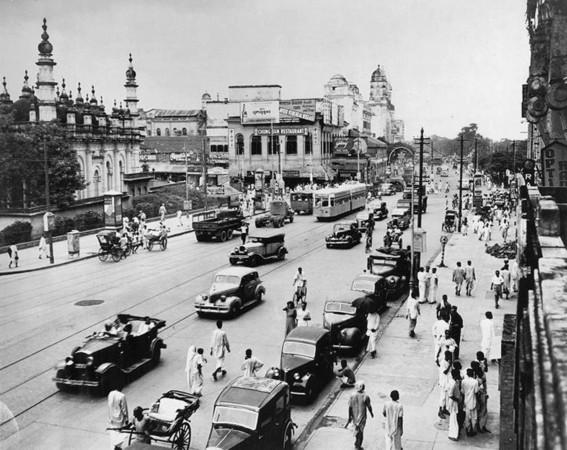
Chowringhee Road, 1940. One of the finest
promenades in the world at the time. As part of the Allied Offensive in China
in 1942-43, three make shift airstrips were built in Burma. They were
nicknamed Broadway, Piccadilly and Chowringhee, which demonstrates the league
that this promenade kept at the time. |
The Golden Thirties was indeed the golden age of Calcutta.
The city knew no shortages. The streets glowed in its electric lights. Trams and
motor buses plied the streets and motor cars were beginning to outnumber
horse-drawn coaches. Theater, cinema and fine dining defined Calcutta's social
life. Great Eastern, Spence's and the newer Grand and Continental were the
finest hotels in the continent. The shops of New Market and stores like the Army
& Navy and Whiteway, Laidlaw & Co. did brisk business, and Peletti's,
Firpo and Maxim's served the finest in French and Italian foods on their tables.
Trains linked Calcutta to all over the Indian Empire and ships of all nations
called at its docks. Even the nascent air travel industry could not ignore
Calcutta. Imperial Airways' service linked Calcutta to London, while Calcutta
was an important stop on the Paris to Saigon and Amsterdam to Batavia services.
The euphoria over Asia's first Nobel Laureate had just been replaced by one for
a Calcutta University professor becoming the second, even as another scientist
was helping the greatest scientist of the twentieth century, Albert Einstein,
unfurl the secrets of science, sitting in its laboratory. Calcutta's hospitals
and medical colleges were producing vaccines for deadly tropical diseases.
Indeed the din of success rendered the occasional explosion of terrorist bombs
and the sounds of demonstration, out of hearing. Chinese chefs and craftsmen
arrived in Calcutta at about this time to escape Japanese invasion or communist
persecution. Calcutta welcomed everybody, to her own advantage.
|

New Market, 1945. Officially built as the
Sir Stuart Hogg Market in the 1880s but referred to this day as the New
Market, this was one of the first shopping malls in the world. Legend goes
that one could buy tiger's milk here at one time, New Market remains a major
shopping center for residents and visitors alike. |
|

A picture postcard depicting British
Indian Steam Navigation Company's S.S. Wardha berthed at the Kidderpore
Docks. Until the beginning of the second world war, passenger and cargo ships
of all prominent lines around the world connected Calcutta with ports ranging
from New York, Buenos Aires, Liverpool, Venice, Sydney and Honolulu with
regular passenger as well as freighter services. Much disruption happened
during the war, and later the riverine port was found inadequate for larger
ships and slowly went into decline, rather like the Tilbury Docks in London. |
|
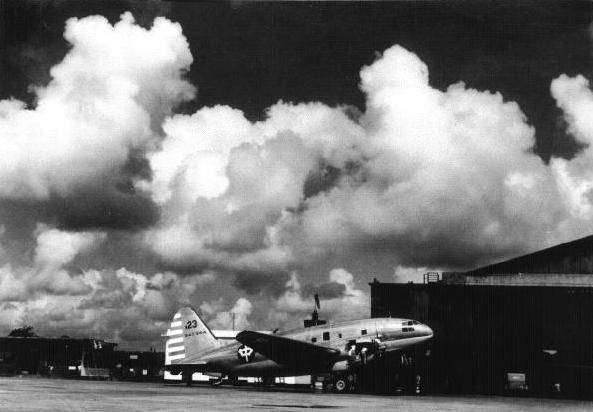
Dum Dum Aerodrome, 1944. Calcutta was an
obvious destination for all airlines of the world. Calcutta appeared on KLM's
Amsterdam-Batavia (now Jakarta) route in 1928, on Air Orient's (later renamed
Air France) Paris-Saigon route in 1933 and Imperial Airways' London-Hong
Kong/Singapore route in 1934. China National Aviation Company flew a Shanghai
- Hong Kong - Chungking - Calcutta service in 1937. As a matter of fact, CNAC
shifted its operational headquarters to Calcutta after Shanghai fell to the
Japanese. |
|
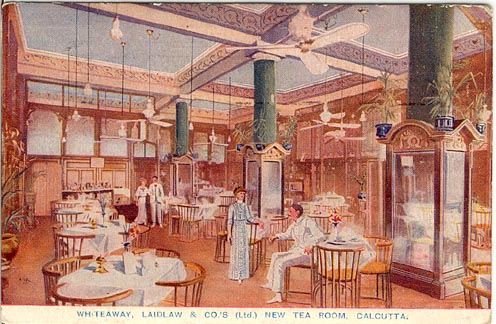
A picture postcard depicting the tea room
of Whiteway, Laidlaw & Co., the famous Calcutta departmental store that
once rivaled Harrod's, Macy's and Mitsukoshi. |
The 1940s brought gloom to Calcutta as with the rest of the
world. As trade collapsed and all energies were channeled into the war effort,
Calcutta watched as the Japanese army overran nation after helpless nation until
it stood at the Eastern borders of India. For the first time since Clive and
Watson restored the Union Jack on Fort William, Calcutta was under direct threat
of invasion. The invasion came this time from the air. Calcutta's dockyards and
several residential areas were bombed, though the damage was very little. Fear,
however, set in and several citizens began to depart the city, even while
refugees from Burma and other areas actually overrun by the Japanese began
arriving by the millions on the streets of Calcutta. And as if its woes were no
less, the parallel agitation for a Moslem homeland in India began to gain
ground. Fueled by the British policy of divide and rule, India burned both under
the impact of the Independence Movement and communal riots. Nowhere, were they
more severe than in Calcutta, in spite of its great tradition in secularism.
Calcutta's contribution to the war effort is tremendous though very often
forgotten. In 1943, Bengal chose to take upon itself the greatest man-made
famine ever, in order to feed the besieged Allied forces in China. For months
the starving masses of humankind watched as supplies were flown over the
Himalayas. The famine resulting from the biggest airlift in history until then
left millions dead.
The Second World War ended with little doubts that the
British would leave. The biggest issue left however was that of the imminent
partition of India into Hindu and Moslem states. As the issue of partition was
being debated in London and New Delhi, the Great Calcutta Killings of August
1946 commenced. The fight between the Indian National Congress and the Muslim
League claimed thousands of lives. The Indian Empire was partitioned on August
14, 1947 creating the two states of India and Pakistan.
|

An advertisement of the 1953 Baby
Hindusthan. Hindusthan Motors started manufacturing Morris automobiles at
their factory near Calcutta in 1943. This factory, to this day, continues to
manufacture the Ambassador, the classic Morris Oxford with a minor
variations, the standard taxi cab in Calcutta. |
Calcutta's glory as the second city of the British Empire
ended with the lowering of the Union Jack from the mast atop Fort William on
August 15, 1947. The departure of her creators deprived Calcutta of her special
status, and partisan treatment by the succeeding rulers and the apathy of her
own people led to her rapid decline. However, true to her spirit, she continues
to live and prosper even amongst her seeming dereliction.
|